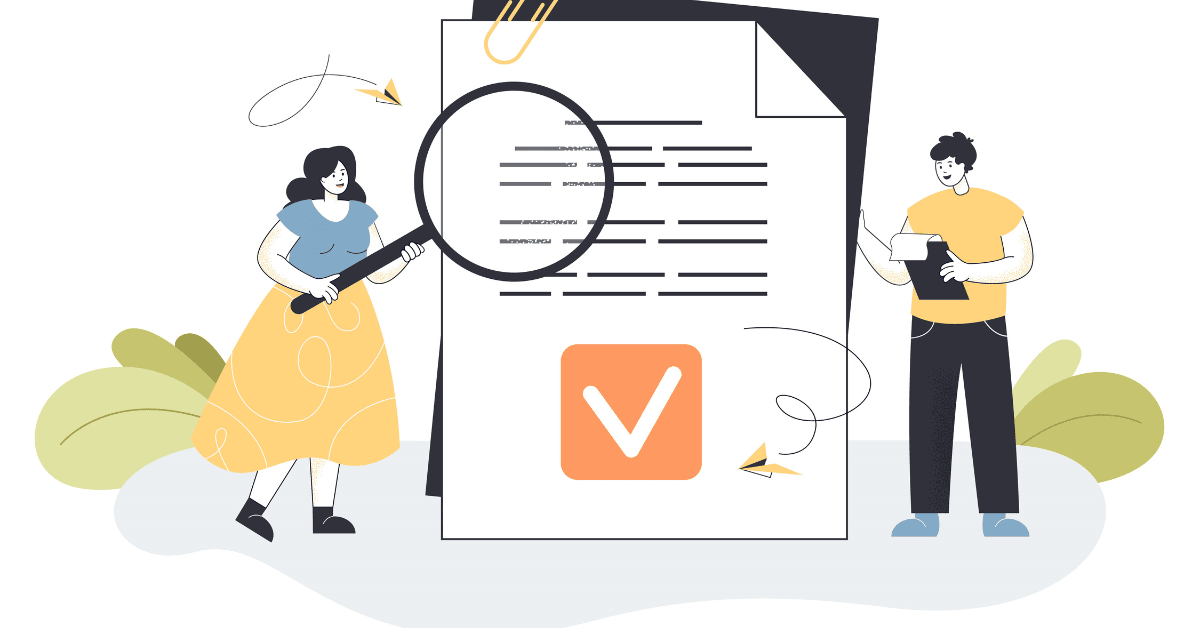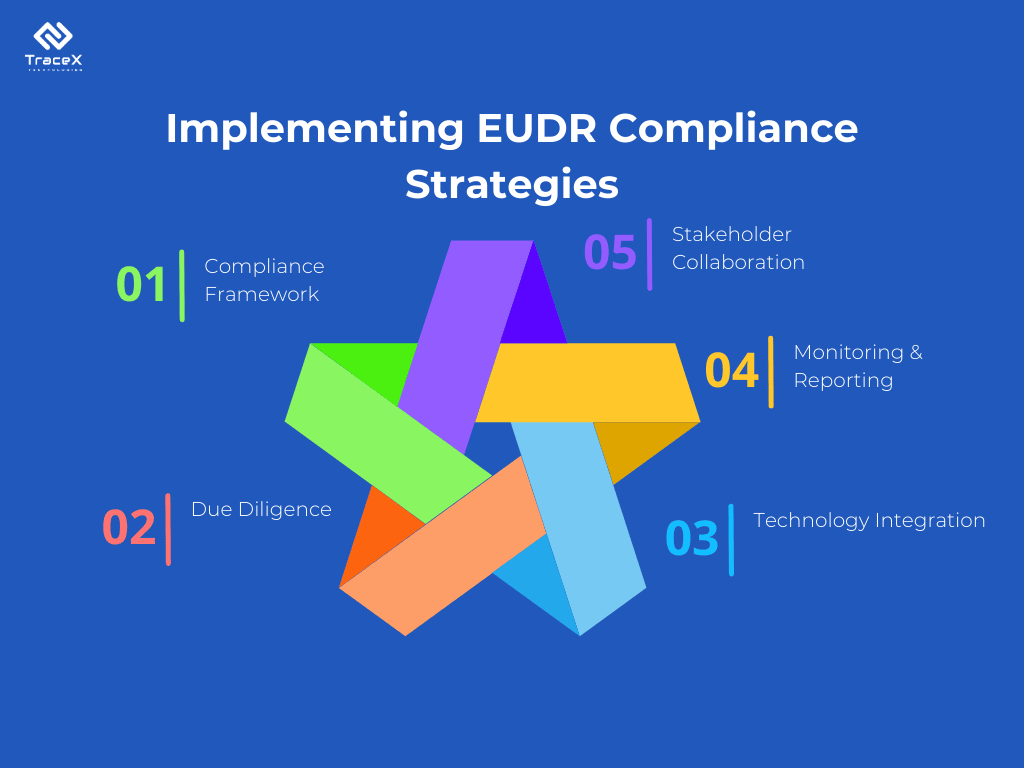Contact: +91 99725 24322 |
Menu
Menu
Quick summary: Ensure EUDR compliance with confidence! Develop effective compliance strategies to navigate deforestation challenges. Simplify due diligence, enhance transparency, and reduce risks with our expert guidance. Streamline compliance and ensure regulatory adherence.

The European Union has introduced the European Union Deforestation Regulation (EUDR) as part of its broader strategy to combat climate change and environmental degradation. Implementing effective compliance strategies is crucial for navigating these challenges and ensuring regulatory adherence.
The EUDR mandates that companies trading in certain commodities must ensure their supply chains are free from deforestation and forest degradation. This regulation presents significant challenges for businesses, particularly those in agribusiness and related sectors.
According to Nature Conservancy, accounting for 13-16% of global deforestation linked to international trade, the EU’s import of commodities like soy, palm oil, and beef contributes to the loss of 203,000 hectares of forest annually, releasing 116 million tonnes of CO2. This underscores the urgent need for robust regulations like the EUDR.
The European Union Deforestation Regulation (EUDR) is a legislative framework aimed at preventing products linked to deforestation and forest degradation from entering the EU market. It applies to various commodities, including soy, palm oil, coffee, cocoa, wood, rubber, and beef. The regulation requires companies to demonstrate that these products have not been sourced from land that has been deforested or degraded since December 31, 2020.
1. Due Diligence Requirements: Companies must conduct thorough due diligence to ensure their supply chains are compliant with EUDR standards.
2. Documentation and Reporting: Detailed documentation and reporting are required to prove compliance.
3. Supply Chain Transparency: Enhanced transparency and traceability are essential for meeting EUDR requirements.
4. Risk of Non-Compliance: Failure to comply with EUDR can result in severe penalties, including fines and restrictions on market access.
The EUDR defines a ‘forest’ as land that covers more than 0.5 hectares, with trees exceeding 5 meters in height and a canopy cover of over 10%, or trees that can reach these criteria in situ.
Applying this definition consistently across different regions, especially in tropical areas, poses significant challenges. In tropical climates, the rapid growth of vegetation can quickly meet the EUDR’s forest criteria. Even land left unattended for a short period can rapidly develop dense vegetation that qualifies as a forest under this definition.
For example, a plot of land cleared in 2019 but left to naturally reforest might be classified as a ‘forest’ based on the EUDR definition and the EU’s map overlay as of December 31, 2020.
Article 9 mandates the collection of thorough, verifiable information to prove that products have been produced in accordance with the relevant legislation of the production country, including Land Use Rights, Environmental Protection, Forest Rules, Third-Party Rights, Labour Rights, Human Rights, FPIC, Tax & Trade Laws.
Navigating the requirements of Article 9 can be complex due to several factors. The reference points for evidence can vary widely between countries, creating confusion about what constitutes adequate proof. There is no clear guidance on which authorities or entities are responsible for validating the acceptability of the evidence provided. This lack of clarity complicates communication with the supply chain regarding specific compliance requirements, potentially leading to delays and increased risk of non-compliance.
When compliant goods from various origins are mixed in a blend, the due diligence statement must cover the origins of all products included in the blend since the last time the silo or tank was fully emptied.
This requirement is at odds with the commonly used First-In-First-Out (FIFO) method, which assumes that the oldest entries are used or removed first. For instance, if a product is withdrawn from a tank in 2025, FIFO dictates that it does not need to trace back to the batches added in 2021, when the tank was last emptied.
Implementing this requirement poses several challenges like the need to track and include data for all materials in the silo or tank since the last complete emptying adds significant complexity to the system. There is an obligation to continuously monitor all supplier risks, even if there have been no recent procurements from them, increasing the risk of non-compliance with factors beyond immediate control Adhering to these requirements can lead to substantial operational downtime, which impacts operational efficiency and disrupts supply chains.
Smallholders, who depend heavily on intermediaries due to their lack of economies of scale, face significant challenges in the supply chain. These intermediaries are essential but often create bottlenecks that complicate data collection and traceability.
Many smallholders struggle to meet basic EUDR requirements, such as providing polygon data or proof of legality, despite practicing related standards like human rights. Additionally, smallholders often lack the resources to maintain comprehensive records, resulting in incomplete traceability data.
Many smallholders may be excluded from the market due to compliance challenges. Limited compliance can decrease the availability of commodities, driving up prices. The resulting supply chain disruptions could negatively affect employment in the EU’s affected industries.
Operators must upload traceability and plantation information for every consignment of relevant products entering the EU, adhering to specific data formats. This repetitive task can be particularly resource-intensive, especially for bulk commodities and their derivatives, as the same plantation information must be uploaded multiple times for different consignments.
The repetitive nature of this process creates significant administrative burdens, diverting resources from other valuable functions. Managing and uploading extensive data requires additional resources, raising operational expense. The frequent data uploads place a strain on the EU information system, potentially causing system overloads or slowdowns that impact the speed and reliability of data processing.
Building a robust compliance framework is the foundation for addressing EUDR challenges. This framework should include the following components. Create clear policies that outline the company’s commitment to EUDR compliance and environmental sustainability. Establish procedures for due diligence, risk assessment, and monitoring to ensure adherence to EUDR requirements. Provide training for employees and stakeholders on EUDR regulations and compliance practices.
Due diligence is a critical aspect of EUDR compliance. Here’s how to implement effective due diligence processes. Conduct thorough assessments of suppliers to verify that their operations do not contribute to deforestation or degradation. Evaluate the risk of deforestation in supply chains, considering factors such as geographical location and agricultural practices. Use third-party verification services to validate the claims made by suppliers regarding deforestation-free sourcing.
Transparency is crucial for demonstrating compliance with EUDR. Enhance transparency in your supply chain through. Implement traceability systems that track the origin of commodities throughout the supply chain. Utilize data management tools to store and manage compliance-related information, such as supplier certifications and audit reports. Consider using blockchain technology for immutable record-keeping and real-time tracking of commodities.
Technology solutions can streamline compliance efforts and improve accuracy. Invest in compliance software designed specifically for EUDR requirements, offering features like automated reporting and risk management. Utilize geospatial tools to monitor land use changes and detect potential deforestation activities in real-time.
Effective EUDR compliance often requires collaboration with various stakeholders. Work closely with suppliers to ensure they understand and adhere to EUDR requirements. Provide support and resources to help them improve their sustainability practices. Engage with regulatory bodies and industry groups to stay informed about EUDR updates and changes. Participate in consultations and provide feedback on regulatory developments.
Monitoring and reporting are essential for demonstrating compliance and identifying potential issues. Implement the following mechanisms. Conduct regular internal and external audits to assess compliance with EUDR requirements and identify areas for improvement. Develop key performance indicators (KPIs) to measure the effectiveness of your compliance efforts and track progress over time. Publish transparency reports detailing your company’s efforts and achievements in meeting EUDR standards.
Managing risks associated with non-compliance is crucial for maintaining market access and avoiding penalties. Develop strategies to address non-compliance risks. Create contingency plans to address potential non-compliance issues, including corrective actions and mitigation measures. Implement a continuous improvement approach to regularly review and enhance compliance strategies.

TraceX’s EUDR compliance platform is designed to streamline and simplify the complexities associated with meeting EUDR regulations. By providing a robust framework for tracking and documenting every step of the supply chain, TraceX ensures that companies can gather, verify, and report critical data efficiently. The platform facilitates seamless data collection and integration, allowing for accurate traceability of products from smallholders through intermediaries to final markets. With features that automate record-keeping, ensure compliance with legal and environmental standards, and generate comprehensive reports, TraceX reduces administrative burdens, minimizes the risk of non-compliance, and supports companies in maintaining transparency throughout their supply chains. This helps businesses navigate EUDR requirements more effectively and efficiently, ultimately ensuring smoother operations and compliance.
Navigating the challenges of EUDR compliance requires a strategic approach, combining effective due diligence, enhanced transparency, technology integration, stakeholder collaboration, and robust monitoring and reporting mechanisms. By adopting these compliance strategies, businesses can address EUDR challenges, ensure regulatory adherence, and contribute to a sustainable and deforestation-free supply chain. As the EUDR landscape continues to evolve, staying informed and agile in your compliance efforts will be key to long-term success and resilience in the global market.
